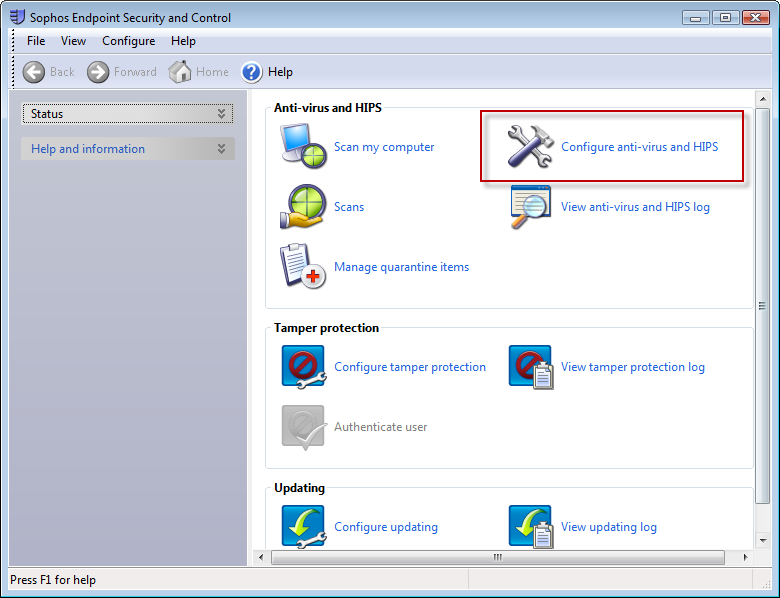

- #HOW TO UNINSTALL SOPHOS CENTRAL ENDPOINT ON MAC HOW TO#
- #HOW TO UNINSTALL SOPHOS CENTRAL ENDPOINT ON MAC DOWNLOAD#
- #HOW TO UNINSTALL SOPHOS CENTRAL ENDPOINT ON MAC FREE#
- #HOW TO UNINSTALL SOPHOS CENTRAL ENDPOINT ON MAC WINDOWS#
You then use the sudorm command to uninstall the app: ‘sudorm-rif “Application folder name”’ with “Application folder name” coming from the list you got from mdfind. The command will then tell you where the files are in your system. You just replace “Application name” with the name of the app you want to uninstall. The syntax is ‘mdfind -name “Application name”’. Once in Terminal, you can issue a mdfind command to find an app’s folder. To use these commands, you need to open a Terminal window. You can then seek the help of an OS X command guide if you need more information. Instead, we will give you the most useful commands. Most users will rarely need them.įor brevity, we will not explain what each command does. Anyone can use them, but issuing the wrong command may break your system, which is why we only recommend them for advanced users. If you can remove an app from your system, you can remove it through command line commands from any terminal window.
#HOW TO UNINSTALL SOPHOS CENTRAL ENDPOINT ON MAC HOW TO#
How to Uninstall Apps on Mac for Advanced Users This is for more advanced users as you need a deep understanding of how OS X works, but it is an option.īefore doing that it may help to keep reading to learn how Disk Drill can find your application folders. You can manually uninstall Mac applications from the command line. If none of them work, there is a fourth option. Most people will only need one of the three solutions above to uninstall their apps. You cannot even remove them from the command line either. OS X will display an error message saying that the system appsare required by the operating system and therefore cannot be modified or removed. Just note that you cannot remove any built-in applications such as the Chess app. You can safely uninstall these apps in the same way if you remember installing them in first place, but we would recommend checking if they have any official instructions at removing them before trashing them. Some apps may ask for a password, but that is because you installed them to your admin folder. You can then Control-click or right-click the Trash icon and choose “Empty Trash” to completely remove the app from your system. You can just drag and drop the app’s icon to the Trash icon on your dock, either from the Application sidebar or Launchpad. To uninstall, you either control-click or right-click the app’s icon, and then select “Move to Trash”. You do this by opening the Application sidebar in a Finder window. app container (which is actually a folder). Thus, you can uninstall them just by deleting their. They do not mess with the rest of your system. The general recommendation is: using the official app’s uninstaller usually bundled with the app itself to remove it completely from your Mac. The ones that are, such as Disk Drill, will only show you where to find every file a program installs on your system. Sure, there are a few uninstaller apps out there, but none of them are worth their price. Other than that, you can use some uninstall program Mac console commands to completely remove the apps. You can search for the left-over files and delete them manually. To ensure that you removed all the files, you need a more advanced uninstall method. Plus, some applications have their own specific uninstall process that you must follow or they will break your system. While harmless, those left-over files can build up over time, leaving you with even less space than before. The above formula leaves junk files behind. However, this will not work for all applications. You can uninstall most applications just by moving their folders to the Trash. On the surface, this seems like an easy task.
#HOW TO UNINSTALL SOPHOS CENTRAL ENDPOINT ON MAC FREE#
Double-click the Remove Sophos Anti-Virus application and follow any on-screen instructions.You need to know how to uninstall programs on Mac computers to free storage space.Unzip the downloaded tool if your browser has not automatically unzipped it.
#HOW TO UNINSTALL SOPHOS CENTRAL ENDPOINT ON MAC DOWNLOAD#
Download the Removal Tool for Sophos Anti-Virus.Use the Standalone Sophos Anti-Virus Removal tool.If the regular uninstaller does not work or if you deleted the built-in removal program, the next method provides a standalone tool to remove the installed Sophos Anti-Virus. Note: Sophos Anti-Virus will not uninstall by dragging it from the Applications folder to the Trash. Note: If the tool exists and not been moved to Trash, Spotlight will find it Click the keys Command + Spacebar to open Spotlight.Repeat the Uninstall process for each Sophos App in the Apps & Features list.Click through the prompts to complete the removal of Sophos Anti-Virus.Under the Apps & Features sections, scroll down the list and find Sophos Anti-Virus.
#HOW TO UNINSTALL SOPHOS CENTRAL ENDPOINT ON MAC WINDOWS#


 0 kommentar(er)
0 kommentar(er)
